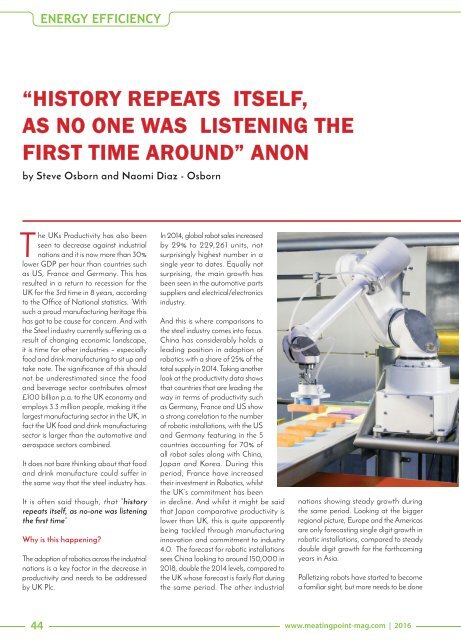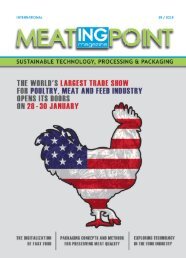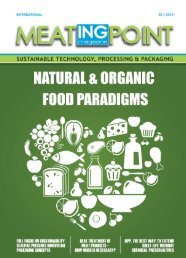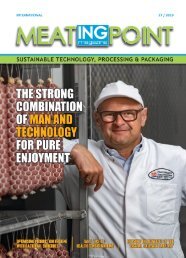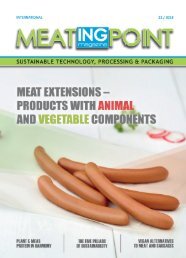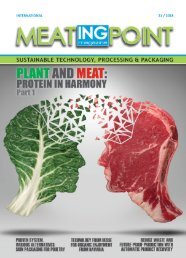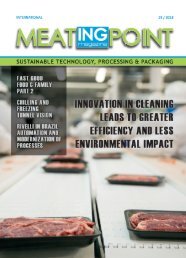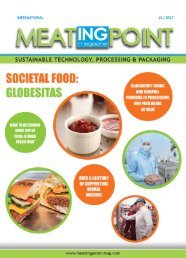MEATing POINT Magazine: #08/ 2016
You also want an ePaper? Increase the reach of your titles
YUMPU automatically turns print PDFs into web optimized ePapers that Google loves.
ENERGY EFFICIENCY<br />
“History repeats itself,<br />
as no one was listening the<br />
first time around” Anon<br />
by Steve Osborn and Naomi Diaz - Osborn<br />
The UKs Productivity has also been<br />
seen to decrease against industrial<br />
nations and it is now more than 30%<br />
lower GDP per hour than countries such<br />
as US, France and Germany. This has<br />
resulted in a return to recession for the<br />
UK for the 3rd time in 8 years, according<br />
to the Office of National statistics. With<br />
such a proud manufacturing heritage this<br />
has got to be cause for concern. And with<br />
the Steel industry currently suffering as a<br />
result of changing economic landscape,<br />
it is time for other industries – especially<br />
food and drink manufacturing to sit up and<br />
take note. The significance of this should<br />
not be underestimated since the food<br />
and beverage sector contributes almost<br />
£100 billion p.a. to the UK economy and<br />
employs 3.3 million people, making it the<br />
largest manufacturing sector in the UK, in<br />
fact the UK food and drink manufacturing<br />
sector is larger than the automotive and<br />
aerospace sectors combined.<br />
It does not bare thinking about that food<br />
and drink manufacture could suffer in<br />
the same way that the steel industry has.<br />
It is often said though, that “history<br />
repeats itself, as no-one was listening<br />
the first time”<br />
Why is this happening?<br />
The adoption of robotics across the industrial<br />
nations is a key factor in the decrease in<br />
productivity and needs to be addressed<br />
by UK Plc.<br />
In 2014, global robot sales increased<br />
by 29% to 229,261 units, not<br />
surprisingly highest number in a<br />
single year to dates. Equally not<br />
surprising, the main growth has<br />
been seen in the automotive parts<br />
suppliers and electrical/electronics<br />
industry.<br />
And this is where comparisons to<br />
the steel industry comes into focus.<br />
China has considerably holds a<br />
leading position in adoption of<br />
robotics with a share of 25% of the<br />
total supply in 2014. Taking another<br />
look at the productivity data shows<br />
that countries that are leading the<br />
way in terms of productivity such<br />
as Germany, France and US show<br />
a strong correlation to the number<br />
of robotic installations, with the US<br />
and Germany featuring in the 5<br />
countries accounting for 70% of<br />
all robot sales along with China,<br />
Japan and Korea. During this<br />
period, France have increased<br />
their investment in Robotics, whilst<br />
the UK’s commitment has been<br />
in decline. And whilst it might be said<br />
that Japan comparative productivity is<br />
lower than UK, this is quite apparently<br />
being tackled through manufacturing<br />
innovation and commitment to industry<br />
4.0. The forecast for robotic installations<br />
sees China looking to around 150,000 in<br />
2018, double the 2014 levels, compared to<br />
the UK whose forecast is fairly flat during<br />
the same period. The other industrial<br />
nations showing steady growth during<br />
the same period. Looking at the bigger<br />
regional picture, Europe and the Americas<br />
are only forecasting single digit growth in<br />
robotic installations, compared to steady<br />
double digit growth for the forthcoming<br />
years in Asia.<br />
Palletizing robots have started to become<br />
a familiar sight, but more needs to be done<br />
44 www.meatingpoint-mag.com | <strong>2016</strong>


